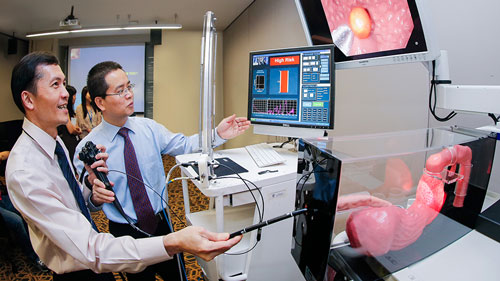| Feb 11, 2014 |
Researchers pioneer world's first real time in-vivo molecular diagnostic system that diagnoses even pre-cancerous tissues during endoscopy
|
|
(Nanowerk News) A National University of Singapore (NUS) team led by Associate Professor Huang Zhiwei, Department of Biomedical Engineering, has developed an In-Vivo Molecular Diagnostic System that could change the way cancer diagnosis is made.
|
|
Their diagnostic system is the only one in the world, so far, clinically proven to be used in human patients for diagnosing even pre-cancerous tissue in gastrointestinal tract during endoscopic examination in real time. Unlike conventional endoscopic techniques that relies on doctors’ eyeball interpretation of the images followed by pathologists’ analysis of the biopsy specimen several days later, their diagnostic system utilises computer analysis of biomolecular information and therefore can provide objective diagnosis of cancer in real time. It is a paradigm shift in how a complex process of cancer diagnosis can be made simply, objectively, and rapidly.
|
 |
| Prof Ho (left) and Assoc Prof Huang demonstrating how their novel diagnostic system works at a media briefing.
|
|
The In-Vivo Molecular Diagnostic System, based on Confocal Raman spectroscopy, includes a proprietary confocal fibre-optic probe and customised online software control system designed by the NUS team. The fibre-optic probe enables the collection of biomolecular fingerprint of tissues in less than one second -- while the online software enables the biomolecular information collected to be extracted and analysed with diagnostic result that is presented in real time during endoscopic examination.
|
|
The In-Vivo Molecular Diagnostic system has been used in more than 500 patients in Singapore across diverse cancer types like stomach, oesophagus, colon, rectum, head and neck, and cervix. The researchers have also published more than 40 peer-reviewed publications -- their most recent publication being “Fiberoptic Confocal Raman Spectroscopy for Real Time In-Vivo Diagnosis of Dysplasia in Barret’s Esophagus” (January 2014) in Gastroenterology, the most prominent publication in the field of gastroenterology. They have also filed two U.S. and two U.K. patents for their invention.
|
|
“We are delighted to not only overcome the technical challenges of weak Raman signal, high fiber background noise, and lack of depth perception by using our specially designed probe, but also to enable real time diagnostic results to be displayed during endoscopy with our customised software,” said Assoc Prof Huang.
|
|
For the clinical testing, the NUS Engineering team has been collaborating with researchers from the NUS Yong Loo Lin School of Medicine led by the School’s Dean, Associate Professor Yeoh Khay Guan; Professor Ho Khek Yu, Head, Department of Medicine; and Associate Professor Teh Ming, Head, Department of Pathology.
|
 |
| A close-up view of the proprietary confocal fibre-optic probe.
|
|
“It has been a long tedious journey of more than 10 years. The journey could be longer if not for the excellent cross-disciplinary teamwork at NUS. The contribution of the NUS clinical team is invaluable in demonstrating the clinical benefits of the system,” added Assoc Prof Huang.
|
|
Assoc Prof Yeoh commented, “This remarkable new system is the first such diagnostic probe that can be used real time, inside the human body, providing almost instantaneous information on cellular changes including cancer and pre-cancer. This is a first in the world development, pioneered here in Singapore. It has the potential to make enormous clinical impact to how cancer is diagnosed and managed. The immediate point-of-care diagnosis during live endoscopic examinations will provide benefits in time and cost-savings, and will improve our patients’ prognosis as a result of early diagnosis.”
|
|
Moving forward, Assoc Prof Huang said they will be conducting clinical trials on a larger scale to further validate the clinical utility of their novel system especially in gastrointestinal cancers.
|
|
Real time and early diagnosis can reduce gastrointestinal cancer deaths
|
|
Gastrointestinal cancer as a class is very prevalent in Asia with stomach and colorectal cancer being the most common cancer types. It is also a very treatable cancer class when diagnosed early. Unfortunately mortality within gastrointestinal cancer is disproportionately high; gastrointestinal cancer is currently the second highest contributor to cancer deaths.
|
|
“We look forward to improving the prognosis of patients with gastrointestinal cancer by facilitating early cancer diagnosis with our In-Vivo Molecular Diagnostic System,” he said.
|


